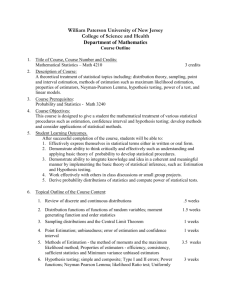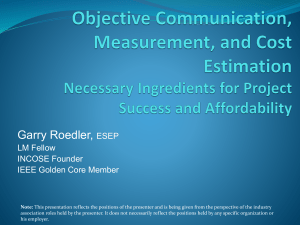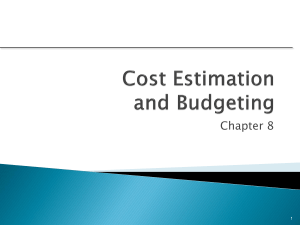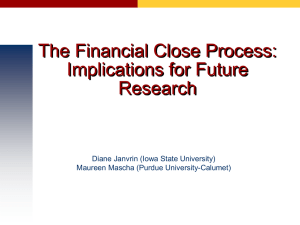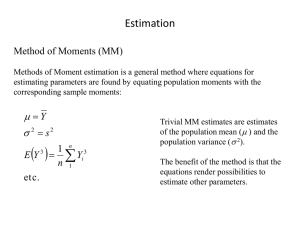T.V.V. Satyanarayana
advertisement
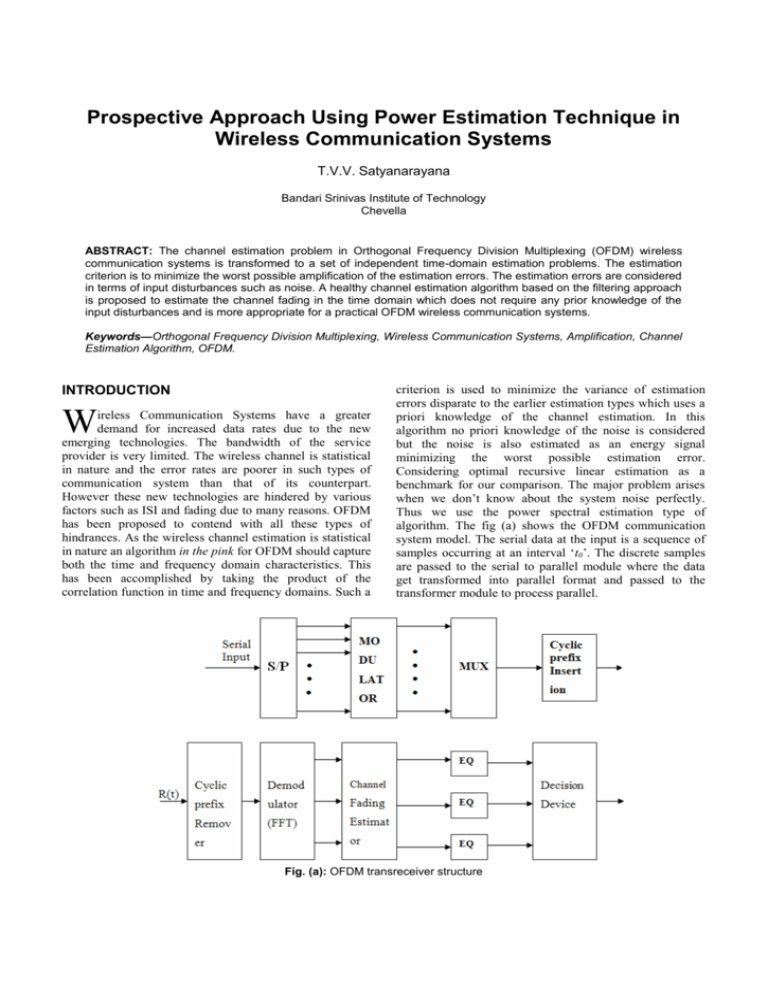
172
Mobile and Pervasive Computing (CoMPC–2008)
Prospective Approach Using Power Estimation Technique in
Wireless Communication Systems
T.V.V. Satyanarayana
Bandari Srinivas Institute of Technology
Chevella
ABSTRACT: The channel estimation problem in Orthogonal Frequency Division Multiplexing (OFDM) wireless
communication systems is transformed to a set of independent time-domain estimation problems. The estimation
criterion is to minimize the worst possible amplification of the estimation errors. The estimation errors are considered
in terms of input disturbances such as noise. A healthy channel estimation algorithm based on the filtering approach
is proposed to estimate the channel fading in the time domain which does not require any prior knowledge of the
input disturbances and is more appropriate for a practical OFDM wireless communication systems.
Keywords—Orthogonal Frequency Division Multiplexing, Wireless Communication Systems, Amplification, Channel
Estimation Algorithm, OFDM.
INTRODUCTION
W
ireless Communication Systems have a greater
demand for increased data rates due to the new
emerging technologies. The bandwidth of the service
provider is very limited. The wireless channel is statistical
in nature and the error rates are poorer in such types of
communication system than that of its counterpart.
However these new technologies are hindered by various
factors such as ISI and fading due to many reasons. OFDM
has been proposed to contend with all these types of
hindrances. As the wireless channel estimation is statistical
in nature an algorithm in the pink for OFDM should capture
both the time and frequency domain characteristics. This
has been accomplished by taking the product of the
correlation function in time and frequency domains. Such a
criterion is used to minimize the variance of estimation
errors disparate to the earlier estimation types which uses a
priori knowledge of the channel estimation. In this
algorithm no priori knowledge of the noise is considered
but the noise is also estimated as an energy signal
minimizing the worst possible estimation error.
Considering optimal recursive linear estimation as a
benchmark for our comparison. The major problem arises
when we don’t know about the system noise perfectly.
Thus we use the power spectral estimation type of
algorithm. The fig (a) shows the OFDM communication
system model. The serial data at the input is a sequence of
samples occurring at an interval ‘t0’. The discrete samples
are passed to the serial to parallel module where the data
get transformed into parallel format and passed to the
transformer module to process parallel.
Fig. (a): OFDM transreceiver structure
173
Prospective Approach Using Power Estimation Technique in Wireless Communication Systems
At the transmitter, the high-rate serial input data
sequence is first serial-to-parallel (S/P) converted into lowrate parallel streams in order to increase the symbol
duration to. The low-rate streams, represented by the
symbols, are modulated onto different sub carriers. In order
to eliminate interference between parallel data streams,
each of the low-rate data streams is modulated onto a
distinct sub carrier belonging to an orthogonal set with sub
carrier spacing 1. The parallel streams are then multiplexed
and a cyclic prefix is added to eliminate the effect of ISI.
The transmitter first converts the input data from a serial
stream to parallel sets. Each set of data contains one
information bit for each carrier frequency. Then, parallel
data are modulated to get the orthogonal carrier
frequencies. The IFFT converts the parallel data into time
domain wave forms. Finally these waveforms are combined
to create a single time domain signal for transmission. After
modulation the parallel data is converted to serial data by
using multiplexer. Then cyclic prefix is added to prevent
ISI by creating a cyclically extended guard interval where
each OFDM symbol is precede by a periodic extension of
the signal itself. The total symbol duration is
Ttotal Tg T
M 1
y t bm k e j 2 mt / T ,
kT t (k 1)T
m 0
where bm[k] is the kth data symbol of the mth stream, M is
the total number of subcarriers, and Ψ is the length of the
guard interval. The transmitted signal y(t) passes through
the wireless channel which introduces distortion and
additive noise. The wireless channel can be modeled as a
multipath frequency selective fading channel using a
tapped-delay line with varying coefficients and fixed tap
spacing represented as
X
h(t , ) hl t l
l 0
where hl(t) and l are the complex amplitude and delay of
the lth path. For OFDM to be effective, the length of the
cyclic prefix should be larger than the maximum
multipath delay spread of the channel.
The received signal r(t) in the kth symbol duration can
be expressed as
T t h tl y t T d
X
h t y t T n t
l 0
l
=
M 1
1 X
hl kT bm k e j 2 qt / T
T l 0
m0
k 1T
kT
+
= ck , q H k , q
e
2 j m q t / T
dt
1 k 1T
n t e j 2 qt / T dt
T kT
vk , q
where
Ck,q = bq[k]
X
where ‘Tg’ is the guard interval and ‘T’ is the useful symbol
duration. Now considering the analysis, the transmitted
signal during the kth symbol interval y(t) is given by
=
achieved by FFT and IFFT. Synchronization of the outputs
of the demodulator and channel estimator is carried out by
using delay blocks. Considering the channel impulse
response as quasi-static during the kth symbol interval so
interchannel interference can be neglected than that of the
background noise. The demodulator output can be
expressed as
Sk,q =
M 1
1 k 1T X
j 2 m t / T
ht kT bm k e
n t e j 2 qt / T dt
T kT l 0
m 0
l
where n(t) is the background noise.
On receiving the signal at the receiver it is demodulated
by removing the cyclic prefix. Practical Implementation is
H k , q hl kT e j 2 qn / T
l 0
1 k 1T
n t e j 2 qt / T dt
T kT
If the channel fading characterized by Hk,q are known,
then coherent detection and optimum diversity are achieved
at the receiver. But this is time varying and unknown.
Hence a good channel estimation algorithm is necessary.
Consider the state-space model and no assumptions are
made as in that of the optimal recursive linear estimation
except having finite energy. In optimal recursive linear
estimation, we consider both noise and background noise
are uncorrelated with Gaussian processes with zero means
and variances and the error is estimated using posteriori
and priori covariances. But both the noise from the
environment and the background noise, both are stochastic
in nature. The estimation is given by
vk , q
ek Z k Z k
where Z k is the estimate of Zk, which is given by ZK = XK,
where is a 1 × n linear transformation operator. Thus the
power estimation approach achieves estimation using a
linear combination of channel state variables. This power
estimating analysis provides us the optimal estimate of XK.
For the state-space model equations listed above there
exists for ZK if and only if there exists a definite solution P k
to the following discrete time Riccati type equation
Pk 1 APk I QPk CTVH1CPk
P0 = P0
1
AT BWH BT
174
Mobile and Pervasive Computing (CoMPC–2008)
where P0 is the initial condition. If a solution Pk exists then
the estimator is given by
Z k X k , k = 1, 2, 3, …
where
CP C V
Xk AXk 1 Gh sk CAXk 1 , X0 0n1
Gk Pk I QPk CT VH1
1
T
k
1
H
where GK is the gain of the estimator. In this design the
larger the value of , less will be the interference effect on
the estimation error. Thus the value of must be selected
with utmost care. For PK+1 to be guaranteed to be a
positive definite it requires
Pk I QPk CTVH1CPk
1
0
Pk-1 γQ CT VH-1C 0
γ –1 (Pk–1 CT VH-1C)>Q
Thus the power estimation technique provides better
communication than its counterparts which minimizes the
effect of worst disturbance on the estimation error and less
sensitive to the channel statistics.
γ –1I>Q(Pk–1 CT VH-1C) –1
REFERENCES
γQ P C V C
–1
k
T
-1
H
γ –1 >max eig Q Pk–1 CT VH-1C
1
where max{eig(X)}denotes the maximum eigenvalue of the
matrix which is formed by X.
Performance analysis is considered by considering
optimal recursive linear estimation and this optimal power
estimation technique.
[1] Camino, Jr., L.J., “Analysis and simulation of a digital
mobile channel using orthogonal frequency division
multiplexing,” IEEE Trans. Commun., vol. COM-33,
pp. 665–675, July 1985.
[2] “Mobile communications”—Jochen Schiller, Second Edition.
[3] “Adaptive filter theory”—Simon Haykin, Fourth Edition.
[4] Borah, D.K. and Hart, B.D. “Frequency-selective fading
channel estimation with a polynomial time-varying channel
model,” IEEE Trans. Commune., vol. 47, pp. 862–873, June
1999.
[5] Edfors, O., Sandell, M. and van de Beek, J., “OFDM channel
estimation by singular value decomposition,” IEEE Trans.
Commun., vol. 46, pp. 931–939, July 1998.
[6] van de Beek, J., Edfors, O., Sandell, M., Wilson, S.K. and
Börjesson, P.O. “On channel estimation in OFDM systems,”
in Proc. 45th IEEE Vehicular Technology Conf., Chicago,
IL, July 1995, pp. 815–819.
[7] Petersen, I.R. and Savkin, A.V., Robust Kalman Filtering for
Signals and Systems with Large Uncertainties. Boston, MA:
Birkhäuser, 1999.
This current power estimation outperforms the currently
existing estimation techniques overall the SNR ranges
considered.
[8] Omidi, M.J., Pasupathy, S. and Gulak, P.G. “Joint data and
Kalman estimation of fading channel using a generalized
Viterbi algorithm,” in Proc. ICC’96, Dallas, TX, June 1996,
pp. 1198–1203.
[9] “Communication system”—Simon Haykin—4th edition.
